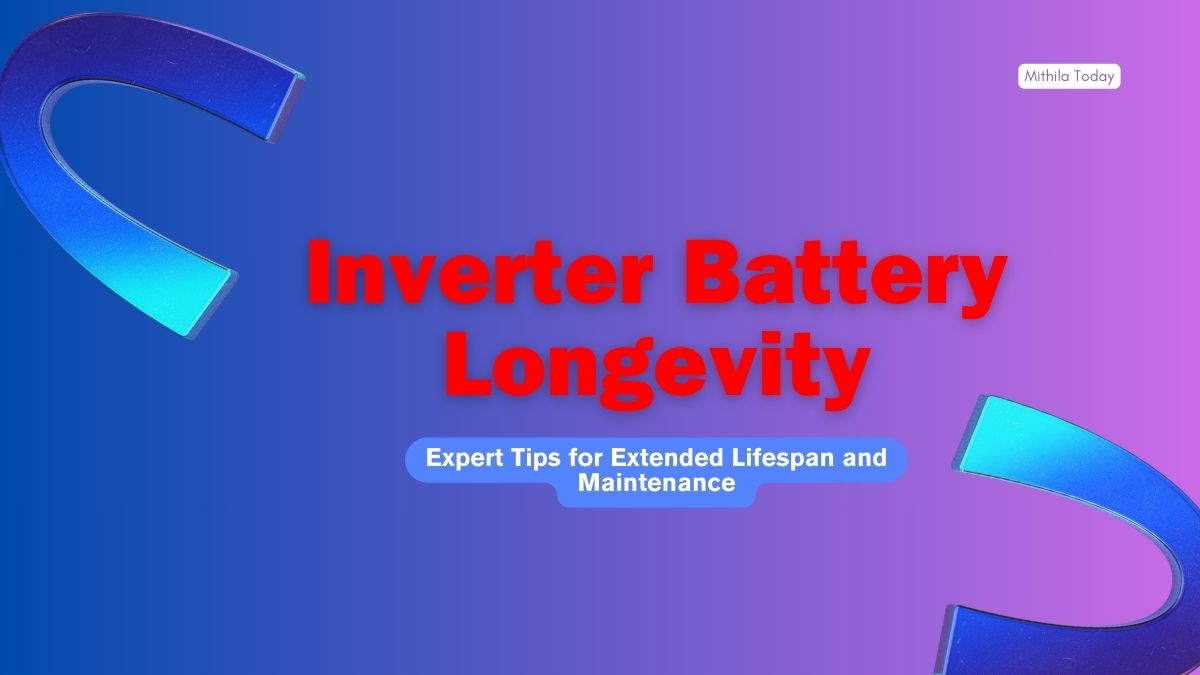In today’s dynamic world, where a constant power supply is paramount, the inverter stands as a stalwart companion during unforeseen outages. At the heart of this essential device lies its battery, and the key to ensuring its sustained performance is a nuanced understanding of proper care and maintenance. In this detailed guide, we delve into practical and essential tips that can significantly impact and extend the lifespan of your inverter battery.
Page Index
Understanding the Basics
The inverter, a sophisticated electronic device, serves the critical function of converting Direct Current (DC) to Alternating Current (AC). As the backbone of uninterrupted power during blackouts, the inverter’s effectiveness is intricately tied to the health and longevity of its associated battery.
Factors Affecting Battery Lifespan
The lifespan of an inverter battery is intricately linked to two primary factors: usage patterns and the level of maintenance it receives. Despite the label “maintenance-free,” all batteries, including those advertised as such, necessitate regular care to function optimally over an extended period.
Temperature Considerations
- Impact of Temperature Fluctuations: Extreme temperatures, whether too high or too low, can significantly affect battery performance. High temperatures accelerate chemical reactions within the battery, leading to faster degradation. Conversely, low temperatures can reduce the efficiency of the chemical reactions, limiting the battery’s ability to deliver power effectively. Thus, maintaining a consistent temperature range is crucial for maximizing battery lifespan.
- Temperature Control Measures: Implementing temperature control measures, such as installing temperature-regulating devices or placing the inverter in a climate-controlled environment, can mitigate the adverse effects of temperature extremes. This ensures that the battery operates within an optimal temperature range, promoting longevity.
Depth of Discharge (DoD)
- Understanding Depth of Discharge: The depth to which a battery is discharged during each use, known as Depth of Discharge (DoD), is a critical factor influencing lifespan. Deeper discharges, where a higher percentage of the battery’s capacity is utilized, can contribute to accelerated wear and tear.
- Optimizing Depth of Discharge: To extend battery life, it is advisable to avoid deep discharges whenever possible. Maintaining a shallower DoD, where the battery is not fully drained during each use, can reduce stress on the battery and contribute to a prolonged lifespan.
Charge Cycles
- Understanding Charge Cycles: The number of charge cycles a battery undergoes refers to the complete charging and discharging of the battery’s capacity. Each charge cycle contributes to the overall wear and tear of the battery.
- Pacing Charge Cycle Usage: Being mindful of the number of charge cycles a battery undergoes can impact its longevity. Pacing the usage of charge cycles by optimizing energy consumption and utilizing power-saving features can extend the overall lifespan of the battery.
Overcharging and Undercharging
- Impact of Overcharging: Overcharging a battery can lead to the generation of excessive heat, causing damage to the battery’s internal components and accelerating deterioration.
- Impact of Undercharging: Similarly, consistently undercharging the battery can result in sulfation, a condition where sulfate crystals accumulate on the battery plates, diminishing its capacity and performance over time.
- Optimal Charging Practices: Employing smart charging technologies that prevent overcharging and ensuring that the battery is adequately charged without being undercharged are vital practices. This helps maintain a balanced charge-discharge cycle, promoting a healthier and prolonged battery life.
Quality of Components
- Role of Quality Components: The overall quality of the battery’s components, including the type of lead-acid technology used and the materials in the construction, plays a pivotal role in determining its lifespan.
- Investing in Quality: Opting for high-quality batteries, even if they come at a slightly higher cost, can be a wise investment. Quality components are designed to withstand rigorous usage and provide better resistance to wear and tear, contributing to a longer and more reliable battery life.
Manufacturer Guidelines
- Adherence to Manufacturer Guidelines: Following the manufacturer’s guidelines regarding usage, maintenance, and charging practices is imperative. Manufacturers provide specific instructions tailored to their battery models, and adhering to these guidelines ensures that the battery operates within its intended parameters.
- Regular Manufacturer Updates: Staying informed about any updates or recommendations from the manufacturer allows users to implement changes in their maintenance routine, aligning with the latest best practices and preserving the battery’s health.
By considering these additional factors affecting battery lifespan, users can implement a holistic approach to battery care, addressing various aspects that collectively contribute to an extended and efficient inverter battery life.
Battery Maintenance Tips
Highlights essential and pivotal guidelines for the proper care and upkeep of an inverter battery. These tips are identified as crucial because they play a fundamental role in preserving the battery’s health, maximizing its lifespan, and ensuring optimal performance.
Addressing the key aspects such as placement, cleanliness, water usage, corrosion prevention, ventilation, and regular discharge practices helps to maintain your inverter battery in good health for a longer time.
The emphasis on these tips underscores their significance in maintaining the longevity and efficiency of the inverter battery, offering a comprehensive guide for users seeking to optimize their power backup system.
1. Optimal Placement:
Installing the inverter battery in a well-ventilated area is paramount. Adequate ventilation mitigates the risk of overheating, a common culprit for reduced battery lifespan. A properly ventilated space also minimizes the need for frequent watering, contributing to a more sustainable and efficient power supply.
2. Regular Cleaning:
Ensuring the cleanliness of battery terminals is a simple yet vital maintenance practice. Regular cleaning eliminates accumulated carbon deposits, facilitating a seamless flow of energy within the battery. This, in turn, enhances the overall efficiency and lifespan of the battery.
3. Distilled Water Usage:
Maintaining the correct water levels within the battery is crucial for optimal performance. Using distilled water, as opposed to tap or rainwater laden with minerals, is imperative. Distilled water helps prevent the accumulation of impurities, preserving the battery’s integrity and extending its operational life.
4. Prevent Corrosion:
After a thorough cleaning session, applying a thin layer of petroleum jelly to the battery terminals serves as a protective measure against corrosion. This simple yet effective practice acts as a shield, preserving the terminals, nuts, and bolts and further contributing to the longevity of the battery.
5. Proper Ventilation:
Ensuring proper ventilation in the vicinity of the inverter is more than just a matter of comfort; it is a critical factor in prolonging battery life. Efficient heat dissipation not only reduces the need for constant watering but also mitigates the risk of gas accumulation, creating a safer environment for both the battery and its surroundings.
6. Battery Discharge:
Regularly discharging the battery, even in the absence of a power outage, is a proactive measure against deep discharge issues. This practice ensures that the battery remains in optimal condition, preventing potential complications that can adversely affect its lifespan.
7. Power Off Monthly:
Periodically powering off the inverter for 30 minutes to an hour each month is a strategic move to prevent deep discharge. This practice aids in maintaining the health of the battery, preventing unnecessary wear and tear that could compromise its performance over time.
Additional Tips for Prolonged Battery Life:
- Fire and Smoke Safety: Keeping the battery away from sources of fire and smoke is not only a safety measure but also contributes to the overall well-being of the battery.
- Adhering to Load Capacity: Operating the inverter within its designed load capacity is crucial. Overloading can strain the battery, leading to potential issues and a shortened lifespan.
- Disconnecting Extra Loads: Disconnecting additional loads when not in use is a prudent practice. This prevents unnecessary strain on the battery, promoting longevity and efficient performance.
- Incorporating Energy-Saving Devices: Introducing energy-saving devices into the power backup system enhances overall efficiency. These devices contribute to a more sustainable and optimized power consumption, benefiting both the inverter and its battery.
- Prompt Replacement of Damaged Batteries: Timely replacement of damaged batteries is essential. Combining old and new batteries within the system can lead to imbalances and decreased overall performance.
- Routine Maintenance Awareness: Regular, routine maintenance serves as a proactive approach to identify changes or issues with the inverter and battery. Staying informed about the system’s health allows for timely interventions, ensuring sustained functionality.
In conclusion, the inverter and its associated battery are not merely appliances but investments in a seamless and uninterrupted power supply. By adhering to these detailed maintenance tips, you not only ensure a longer lifespan for your inverter battery but also contribute to the overall efficiency of your power backup system.
The adage “a stitch in time saves nine” holds particularly true in the realm of inverter battery maintenance. A mindful and proactive approach today can avert potential disruptions tomorrow, ensuring a reliable power supply when you need it the most.


